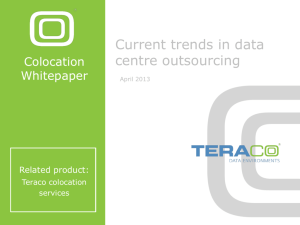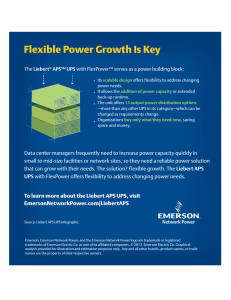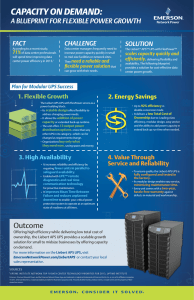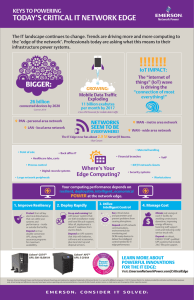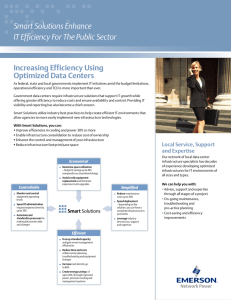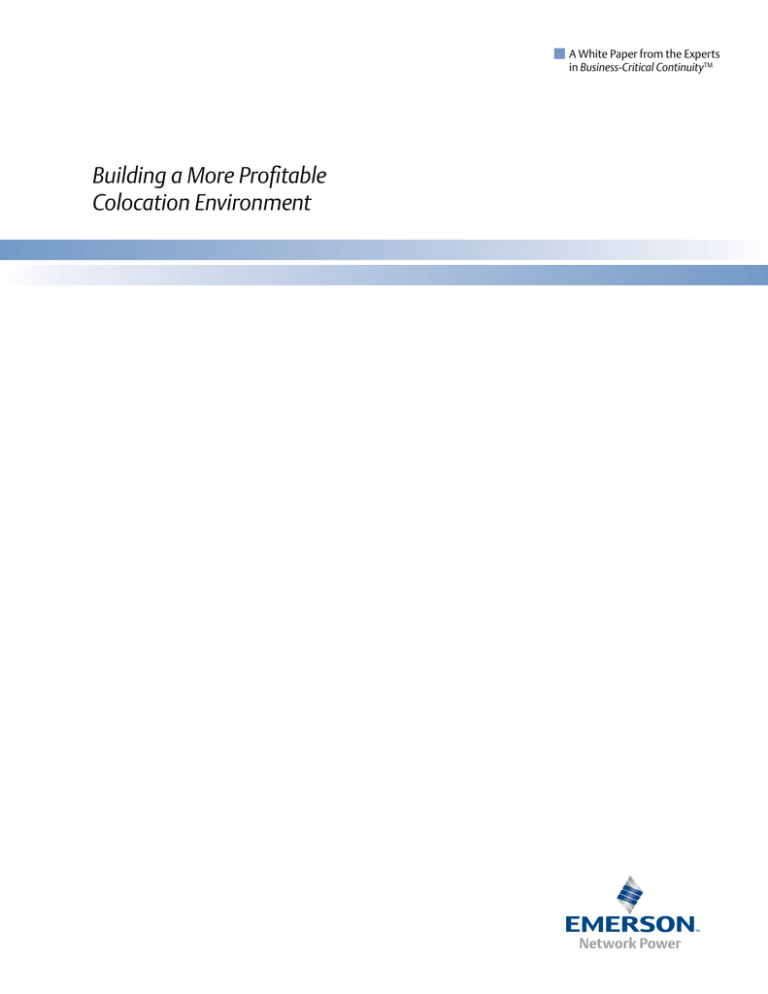
A White Paper from the Experts
in Business-Critical ContinuityTM
Building a More Profitable
Colocation Environment
Introduction
Data center management is currently undergoing a period of great change, much of which is being driven
by two factors: new technologies and increasing demands. Data center managers are struggling to keep
pace with growing capacity needs while working under the constraints of tightened budgets and energy
efficiency initiatives. New technologies such as virtualization, cloud computing and data center infrastructure
management (DCIM) are transforming data centers into dynamic environments, optimizing the space in ways
no one could have predicted only a few short years ago.
Under this new “norm,” data center managers are finding that they now must lower operational expenses,
justify equipment upgrades, delay capital expansions and explore ways to reduce energy consumption and
meet growing demand without risking downtime, all while optimizing to accommodate future needs. To meet
these sometimes conflicting objectives, one option data center managers are increasingly turning toward is
third-party colocation.
This white paper is designed to provide colocation facilities with best practices for building a scalable data
center infrastructure that will enable them to quickly add customers, while optimizing efficiency at every stage
of infrastructure utilization.
2
Challenges Faced by
Colocation Providers
According to results of the Uptime Institute’s 2012
Data Center Survey, “around half of the respondents
will turn to third party data center providers to deal
with data center growth in the next 12-18 months.”
Nearly 62 percent of respondents to a 2012 Data
Center Users Group (DCUG) study sponsored by
Emerson Network Power have considered colocating
their data center. Slightly more than 38 percent of
that group reported that they did move forward
with colocating at least a portion of their data
center (Figure 1).
As colocation providers work to meet this new
demand for their services, they are driving major
changes in the industry. Customer demands, such
as faster speed of deployment, energy efficiency,
higher availability and capacity-on-demand, are
driving colocation providers to incorporate new and
innovative technologies; and according to a 2012
Emerson Network Power customer survey, they
are installing the technology at a faster pace than
enterprise data centers (Figure 2).
Considered and decided to colocate entire data...
Tweet This:
#Colocation
providers adopting
new #datacenter
technologies at a
much faster pace
than enterprise
counterparts:
http://bit.ly/Yu7kny
7.9%
Considered, and decided to colocate a portion of our...
30.5%
Considered, but decided against colocating data...
23.2%
Have not considered, but probably will in the future
8.5%
Have not considered, and will not consider in the..
29.9%
0%
5%
10%
15%
20%
25%
30%
35%
Figure 1. The Data Center Users Group members consider colocation (Fall 2012).
Colocation
Enterprise
DC Power for servers
35%
8%
Transformer-free UPS
27%
6%
High Redundancy in Critical Path
54%
38%
Higher Voltages
27%
15%
Power Containers / Skids
16%
6%
Economization
11%
7%
Modular Chilled Water Plants
30%
17%
Figure 2. Colocation providers installing new technology at higher rate than enterprise
data centers (Fall 2012).
3
Availability, Efficiency and Scalability
New technologies and approaches to data center
design and operation share attributes which drive
improvement in three areas: availability, efficiency
and scalability. These attributes all contribute to
the bottom line by:
Tweet This:
White paper
shows how #colo
providers can achieve
the “trifecta” of
availability, efficiency
& scalability
http://bit.ly/Yu7kny
1) Reducing costs though a just-in-time approach
to infrastructure deployment.
2) Improving uptime by avoiding penalty fees and
lowering operating costs through deploying
energy efficient technology.
Availability of IT capacity has traditionally been
the most important metric on which data centers
are evaluated, which is a fact well understood by
colocation providers. However, all data centers today
must operate efficiently—in terms of both energy and
management resources—and be flexible enough to
quickly and cost-effectively adapt to both changes in
both business strategy and computing demand.
Many in the industry are beginning to realize that
using scalable infrastructure technologies for
operation and management allows dynamic IT
systems and data centers to achieve availability while
maximizing opportunities to improve energy and
operational efficiencies.
Availability
Efficiency
4
Scalability
This “trifecta” of availability, efficiency and scalability
is especially important for colocation providers, since
the data center is their business. Every opportunity
to increase availability, efficiency and scalability is an
opportunity to increase competitiveness and build the
bottom line. For customers, the value proposition of
the colocation provider is that they can do it “cheaper”
and “faster” while delivering better reliability. To
deliver on this value proposition, colocation providers
need to do everything they can to optimize the
performance of their facilities.
Infrastructure Best Practices
for Colocation Facilities
The following strategies expand upon existing
data center design approaches and help colocation
providers meet their value proposition through a
sophisticated, flexible infrastructure that enables
them to deploy capacity faster at a lower cost and with
greater reliability.
Faster Deployment through Scalability
One of the most important challenges that must be
addressed in any data center, especially colocation
facilities, is configuring systems to meet current
requirements while ensuring the ability to quickly
and cost-effectively meet growing and fluctuating
performance and capacity needs. In the past,
this was partially accomplished by oversizing
infrastructure systems and letting the data center
grow into its infrastructure over time. As many
organizations discovered, this approach can
create inefficiencies in terms of both capital and
energy costs.
Today, flexibility can be provided by a new generation
of infrastructure systems that are designed for
simplified configuration and greater scalability,
enabling systems to be right-sized during the design
phase, with potential for planned growth for dynamic
environments. These modular technologies especially
help in managing a data center infrastructure that
experiences fluctuations in capacity needs.
Modularity and scalability of infrastructure equipment
reduces costs and improves deployment speed
during construction and at a room- and rack-level
when adding capacity. These systems typically feature
integrated controls and are built and pretested in
a factory environment. In many cases, they can be
deployed in as little as 14 to 16 weeks. The shorter
deployment time, combined with the “build it as
you need approach” offered by modularity, allows
colocation providers to quickly meet fluctuating
customer demands while lowering capital
expenditure (CapEx) costs.
Hardware-enabled scalability allows quick power
capacity increases with the addition of internal power
core hardware assemblies. These core assemblies allow
the system to expand for capacity or redundancy in
15 kW increments up to 45 or 90kW within a single
cabinet. It is important to look for power cores that
incorporate distributed intelligence and scalable power
in a common assembly and allow configuration of a
completely redundant power and control system, sized
to match the capacity of the protected equipment.
When power requirements change, data center
managers can easily add capacity without increasing
the system footprint. This approach allows for rightThis sort of scalability can come in many forms.
sizing of the UPS, resulting in improved energy
Virtually every component of the physical infrastructure efficiency and reduced power expenditures.
is now available in a modular design. Modularity can
be applied to specific infrastructure equipment such
Modular busway is a flexible, robust power
as UPS systems that can be expanded by adding power distribution system that provides high-density, modular
cores, or rack power distribution units with swappable
busway power distribution to racks while eliminating
power strip receptacles, power cords and power
distribution cable clutter that restricts airflow. The
modules. Modularity can also be achieved holistically
modular design makes it easy to add capacity simply
by quickly adding containerized enclosures to a data
by adding more receptacles and busway sections. It
center when capacity is being added on a large scale.
is an ideal solution for data centers of any size that
experience frequent configuration changes and require
The following list highlights the different forms of
high power distribution and more effective utilization
scalability, beginning at the component level and
of space. The modular design of the busway can offer
ending with room-level.
15 to 30 percent savings in time and installation costs
compared to traditional cable and conduit solutions.
Software-enabled scalability allows data centers
to grow capacity of a base system without additional
hardware. Certain UPS units in the market provide
capacity-on-demand by using software to grow
capacity without adding to the system footprint. UPS
units with this sort of software functionality can be
sized to current requirements and then easily scaled up
to a larger capacity with a simple software key as power
needs change. These types of modules are scalable in
increments, such as from 40 to 60 to 80 kVA, from 80
to 100 to 120 kVA, or from 400 to 500 to 600 kVA.
SmartAisle™ is an example of how scalability at the technology level can be incorporated into an
aisle-configured package that is simple to deploy and cost effective. These contained or open data
center solutions integrate modular power systems, cooling systems with Liebert iCOM™ intelligent
controls, and a DCIM system. They offer the potential to deliver 30 percent energy savings and 25 percent
more capacity than a traditional design, and at high levels of availability. SmartAisle-based integrated
infrastructures are ideal for existing facilities experiencing rapid growth.
5
Tweet This:
“Modular” doesn’t
just mean containersUPS, chillers &
aisle designs can
enable incremental
#datacenter growth
http://bit.ly/Yu7kny
Modular chiller systems provide end-to-end,
chiller-based cooling at a quality level only achievable
in a factory environment. They contain all the
mechanical components used in a traditionally-built
system, including chillers, chilled water pumps,
condenser water pumps, cooling towers, variable
frequency drives, controls and isolation valves, water
treatment, refrigerant monitoring and room-based
IT cooling. The modular approach provides initial
and operational cost savings by allowing data center
managers to add cooling capacity as needed to match
growing IT load.
38%
15%
1%
1%
3%
5%
15%
4%
4%
14%
Modular data centers no longer refer to data
centers in shipping containers. They have evolved
significantly in recent years – integrating power and
48% Power
52% Computing
and Cooling
Equipment
cooling infrastructures to meet the changing needs
of data center managers. These integrated packages
38% Cooling
15% Processor
are built and pretested in factory environments, and
5% UPS
15% Other Services
3%
MV
Transformer
14% Server Power Supply
offer a number of variations on the standard “shipping
and Switchgear
4% Storage
container,” including AC power enclosures and AC
1% Lighting
4% Communication
power skids. These solutions are optimized for critical
1% PDU
Equipment
IT and infrastructure equipment, and are designed
for maximum availability, security, flexibility and
efficiency. Many of these “integrated” offerings are
Figure 3. Energy consumption in a typical
particularly cost-effective due to their pre-configured data center
cooling and power infrastructures, tailored to meet
the exact specifications of the deployment.
Lower Operating Costs
While modular systems do provide opportunities
to lower CapEx costs, there are a number of
technologies and approaches colocation providers
can implement that will significantly reduce
operational expenditure (OpEx) costs. Most of
these focus on the operational efficiency of the
data center environment.
In traditional data centers, approximately one-half
of the energy consumed goes to support IT
equipment with the other half used by support
systems (Figure 3). Emerson Network Power
conducted a systematic analysis of data center
energy use and the various approaches to reducing it
to determine which were most effective. The analysis
documented the “cascade effect,” (Figure 4) which
6
For more information on Energy Logic, see
Emerson Network Power’s ebook: “Energy
Logic 2.0: New Strategies for Cutting Data
Center Energy Costs and Boosting Capacity.”
occurs as efficiency improvements at the server
component level are amplified through reduced
demand on support systems. Using this analysis,
Emerson developed Energy Logic, a vendor-neutral
roadmap of 10 strategies that can reduce a data
center’s energy use by up to 74 percent.
According to the analysis, in a data center with a
PUE of 1.9, 1 W savings at the server processor
create a 2.84 W savings at the facility level as a
result of the cascade effect. At higher PUEs, the
savings are even greater.
Server
Component
1 Watt saved here
-1.0 W
DC-DC
Serves an additional
.18 W here
-1.18 W
-1.49 W
AC-DC
and .31 W here
Power
Distribution
-1.53 W
-1.67 W
UPS
and .04 W here
and .14 W here
Cooling
and 1.07 W here
-2.74 W
Building
Switchgear/
Transformer
-2.84 W
and .10 W here
Figure 4. One Watt saved at the server component level results in cumulative savings of about 2.84 Watts in
total consumption
However, sometimes the use of economizer systems can
Energy Logic - Cooling
potentially introduce new problems. The effect of outside air
on data center humidity should be carefully considered when
A best practice that builds upon the steps in Energy Logic is
evaluating economization. While there are ways to maintain
to optimize the cooling infrastructure. One of the approaches
appropriate humidity levels, they usually offset some of
that help accomplish this is the use of “free cooling.” A
the energy savings provided by the economizer, or achieve
popular approach in the data center has been economizer
reduced energy consumption at the expense of data center
systems that use outside air to provide “free-cooling” cycles.
availability. Figure 5 shows the pros and cons associated with
This approach has been shown to reduce or eliminate chiller
the two most common forms of economization found in data
operation or compressor operation in precision cooling
units, enabling the economizer systems to generate cooling
centers today.
unit energy savings of 30 to 50 percent, depending on the
average temperature and humidity conditions of the site.
For more information on economizers, see Emerson Network Power’s white paper: “Economizer Fundamentals:
Smart Approaches to Energy-Efficient Free-Cooling for Data Centers”
Air-Side Economization
PROS
• Very efficient in some climates
Water-Side Economization
• Can be used in any climate
• Can retrofit to current sites
• Limited to moderate climates
CONS
• Complexity during change-over
• Maintenance complexity
• Humidity control can be a challenge; vapor
barrier is compromised
• Complexity during change-over
• Dust, pollen and gaseous contamination
sensors are required
• Hard to implement in “high density” applications
• Piping and control more complex
• Risk of pitting coils if untreated stagnant water
sits in econo-coils
Figure 5. The pros and cons of the two most common approaches for utilizing outside air to increase energy
efficiency in data center thermal management.
7
One way colocation providers can mitigate the
operational limitations or concerns commonly
associated with air economizer technology is by
installing a cooling system that features technology
pumped refrigerant economizer in a traditional direct
expansion (DX) unit. This type of air-cooled system uses
the same refrigerant circuit, coils and condenser in both
economizer and non-economizer modes. It employs a
two-phase refrigerant versus a traditional single-phase
economizer solution, resulting in a simple and efficient
cooling system that maximizes the hours available to
use reliable free cooling.
Not only does this DX based system utilize cooler
outside air to enable “free cooling”, but these types of
systems enable a “just-in-time” approach to cooling
deployment. There is no need to install a large chiller
plant that is sized for full capacity on day one. By
deploying DX units as capacities and server cabinet
footprints grow, lower capital costs are realized.
The Liebert DSE™ is an example of this type
of cooling system. It incorporates an optional
“free cooling” technology feature called
Liebert® EconoPhase™. At full capacity, the
unit is 114 percent more efficient than an air
economizer, and mitigates the operational
limitations or concerns commonly associated
with air economizer technologies. The Liebert
DSE offers an energy-efficient SCOP (seasonal
coefficient of performance) rating of 2.9,
making it 52 percent more efficient than the
ASHRAE 90.1 (2010) minimum requirement
of 1.9 for data center cooling units. For more
information on the Liebert DSE, visit:
EmersonNetworkPower.com/LiebertDSE
Energy Logic - Power
Another best practice that builds upon the Energy Logic
steps is to utilize double-conversion UPS systems that
feature an economy mode of operation (eco-mode)
to increase energy efficiency and reduce the operating
expenses experienced in the data center.
Eco-mode allows UPS systems to achieve the highest
possible efficiencies by transferring the UPS to operate
on utility power when conditions are ideal. When power
problems are detected, the UPS switches back to double
conversion mode. Until recently, this transfer was not
seamless because when the critical load was being
powered through the bypass, the rectifier and inverter
were switched off. This resulted in a delay and a notch in
the output waveform when the critical load returned to
double-conversion mode.
A new approach, active inverter intelligent eco-mode
(Figure 6) , eliminates this issue by keeping the inverter
and rectifier in an active state, ready to accept the load
nearly seamlessly when transfer occurs.
Intelligent Eco-Mode
Bypass
AC Input
StaticSwitch
Rectifier
Inverter
Rectifier
AC Input
BC
Figure 6. Active inverter intelligent eco-mode
offers a more seamless transfer and UPS
efficiency level up to 99 percent.
8
The use of eco-mode has been gaining support in
the industry. The Green Grid, a global consortium of
companies, government agencies and educational
institutions dedicated to advancing resource efficiency
in data centers and business computing ecosystems,
included eco-mode in its Data Center Maturity
Model. The Environmental Protection Agency (EPA)
also mentioned eco-mode in its recently introduced
ENERGY STAR® for Uninterruptible Power Supplies
specifications as one of the operating modes for
efficiency improvements.
Greater Reliability
Reliability and availability concerns are very familiar
to colocation providers. They basically come down
to economics. The increasing reliance on IT systems
to support business-critical applications has forged
an even stronger connection between data center
availability and total cost of ownership (TCO). One
significant outage can be so costly that it wipes
out years of savings achieved through incremental
efficiency improvements, and can severely impact a
colocation provider’s reputation and bottom line.
The actual costs associated with an unplanned outage
are stunning. A 2011 Ponemon Institute study,
sponsored by Emerson Network Power, revealed that
the mean cost of a data center outage downtime
event is $505,502, with the average cost of a partial
data center shutdown running $258,149 and a full
shutdown costing more than $680,000.
There are a number of ways colocation providers
can achieve greater reliability and meet customer
expectations for 24/7 availability and accessibility.
One very practical step is to utilize service expertise
and regularly scheduled maintenance to extend
equipment life.
For established facilities, preventive maintenance has
proven to increase system reliability. Emerson Network
Power analyzed data from 185 million operating hours
for more than 5,000 three-phase UPS units operating
in the data center. The study found that the UPS Mean
Time Between Failure (MTBF) for units that received
two preventive service events a year is 23 times
higher than a machine with no preventive service
events per year.
Preventive maintenance programs should be
supplemented by periodic data center assessments.
An assessment will help identify, evaluate and resolve
power and cooling vulnerabilities that could adversely
affect operations. A comprehensive assessment
includes both thermal and electrical assessments,
although each can be provided independently to
address specific concerns.
For more information on the causes and
cost of downtime, see Emerson Network
Power’s white papers:
• “Understanding the Cost of Data
Center Downtime”
• “Addressing the Leading Root Cause
of Downtime.”
9
Tweet This:
Avg. cost of a
#datacenter
outage = $505,502;
partial shutdown =
$258,149;
full shutdown =
$680,000
http://bit.ly/Yu7kny
At the UPS level, dedicated battery monitoring
is critical to preventing outages. According to the
Ponemon study, UPS battery failure is the leading
cause of downtime, with 65 percent of respondents
citing it as the cause of their unplanned data center
outages (Figure 7). A dedicated battery monitoring
system that continuously tracks internal resistance
within each battery provides the ability to predict and
report batteries approaching end-of-life to enable
proactive replacement prior to failure.
From a single, unified, dynamic platform, colocation
providers are able to monitor and control the critical
infrastructure (IT and facility equipment), manage
capacity, track inventory, plan changes, visualize
configurations, analyze and calculate energy usage,
optimize cooling and power equipment and account
for the impact of virtualization on the equipment
supporting it. Users are able to manage the system
as a whole, instead of in parts, resulting in higher
utilization of existing infrastructure, increased
personnel efficiency and lower operating costs.
Deploying a data center infrastructure management
(DCIM) platform further optimizes availability. DCIM
technologies enable the unified management of the
data center’s IT and facilities infrastructure, giving
colocation providers unprecedented insight and
action to achieve optimal data center performance
and easily add capacity to meet fluctuating customer
capacity demands.
65%
UPS Battery failure
UPS capacity exceeded
53%
Accidental EPO/human error
51%
UPS equipment failure
49%
Water incursion
35%
Heat related CRAC failure
33%
PDU/circuit bracker failure
33%
0%
10%
20%
30%
40%
50%
60%
70%
Figure 7. Respondents to the Ponemon Institute survey most frequently cited UPS battery failure
as the cause of unplanned data center outages.
10
Conclusion
As data center managers struggle to keep pace with growing capacity needs while working under the
constraints of tightened budgets and energy efficiency initiatives, many are considering third-party colocation
facilities as an alternative to building out their own environments.
In order for colocation facilities to capitalize on this increased interest and customer demand, it is important
that they deliver on their value proposition of doing it “cheaper” and “faster” while delivering better reliability
than an organization can deliver on its own. To accomplish this, they need a sophisticated, scalable data center
infrastructure that will enable them to quickly add customers, while optimizing efficiency at every stage of
infrastructure utilization.
There are a number of new and proven data center infrastructure technologies available that advance the
flexibility of data center environments, increase efficiency and safeguard availability. These technologies will
help colocation providers meet their value proposition by enabling them to deploy faster at a lower cost and
with greater reliability.
11
Emerson Network Power
Liebert Corporation World Headquarters
1050 Dearborn Drive
P.O. Box 29186
Columbus, Ohio 43229
United States Of America
800 877 9222 Phone (U.S. & Canada Only)
614 888 0246 Phone (Outside U.S.)
614 841 6022 Fax
liebert.com
While every precaution has been taken to ensure accuracy and
completeness in this literature, Liebert Corporation assumes no
responsibility, and disclaims all liability for damages resulting
from use of this information or for any errors or omissions.
© 2013 Liebert Corporation. All rights reserved throughout
the world. Specifications subject to change without notice.
All names referred to are trademarks or registered trademarks
of their respective owners.
® Liebert and the Liebert logo are registered trademarks of the
Liebert Corporation. Business-Critical Continuity, Emerson Network
Power and the Emerson Network Power logo are trademarks and
service marks of Emerson Electric Co. ©2013 Emerson Electric Co.
SL-24675 (R05/13)
Emerson Network Power.
The global leader in enabling Business-Critical Continuity™.
AC Power
Connectivity
DC Power
Embedded Computing
Embedded Power
Industrial Power
Infrastructure Management & Monitoring
Outside Plant
Power Switching & Controls
Printed in USA
EmersonNetworkPower.com
Precision Cooling
Racks & Integrated Cabinets
Services


